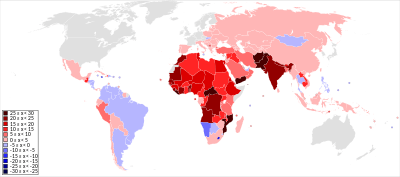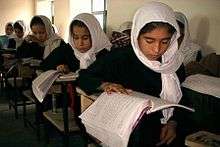Sex differences in education

 |
| This article is one of a series on: |
| Sex differences in humans |
|---|
| Physiology |
| Medicine |
| Sexual differentiation |
| Autism |
| Depression |
| Schizophrenia |
| Stroke care |
| Neuroscience |
| Memory |
| Eyewitness memory |
| Cognition |
| Intelligence |
| Emotional intelligence |
| Psychology |
| Gender psychology |
| Sociology |
| Crime |
| Education |
| Leadership |
| Social capital |
| Suicide |

Sex differences in education are a type of sex discrimination in the education system affecting both men and women during and after their educational experiences.[1] Men are more likely to be literate on a global average, although women are more prevalent at higher education in some countries.
Statistics
Worldwide, men are more likely to be literate, with 100 men considered literate for every 88 women. In some countries the difference is even greater; for example, in Bangladesh only 62 women are literate for every 100 men.[2]
In an OECD study of 43 developed countries, 15-year-old girls were ahead of boys in literacy skills and were more confident than boys about getting high-income jobs.. In the United States, girls are significantly ahead of boys in writing ability at all levels of primary and secondary education.[3] However, boys are slightly ahead of girls in mathematics ability.[4]
Female majority
In the US, the 2005 averages of male and female university participants were pegged at a 43-to-57 ratio.[5] Also, in 2005-2006, women earned more Associate's, Bachelor's, and master's degrees than men and earned 48.9% of Doctorate and 49.8% of first professional degrees.[6] This is repeated in other countries; for example, women make up 58% of admissions in the UK[7] and 60% in Iran. In Canada the 15% gender gap in university participation favored women.[8]
Forms of sex discrimination in education
Sex discrimination in education is applied to women in several ways. First, many sociologists of education view the educational system as an institution of social and cultural reproduction . The existing patterns of inequality, especially for gender inequality, are reproduced within schools through formal and informal processes.[1]
Another way the educational system discriminates towards females is through course-taking, especially in high school. This is important because course-taking represents a large gender gap in what courses males and females take, which leads to different educational and occupational paths between males and females. For example, females tend to take fewer advanced mathematical and scientific courses, thus leading them to be ill-equipped to pursue these careers in higher education. This can further be seen in technology and computer courses.[1]

Also, cultural norms may also be a factor causing sex discrimination in education. For example, society suggests that women should be mothers and be responsible for the bulk of child rearing. Therefore, women feel compelled to pursue educational pathways that lead to occupations that allow for long leaves of absence, so they can be stay at home mothers.[1]
A hidden curriculum may further add to discrimination in the educational system. Hidden curriculum is the idea that race, class, and gender have an influence on the lessons that are taught in schools.[9] Moreover, it is the idea that certain values and norms are instilled through curriculum. For example, U.S. history often emphasizes the significant roles that white males played in the development of the country. Some curriculum have even been rewritten to highlight the roles played by white males. An example of this would be the way wars are talked about. Curriculum's on the Civil War, for instance, tend to emphasize the key players as Ulysses S. Grant, Robert E. Lee, and Abraham Lincoln. Whereas woman or men of color such as Harriet Tubman as a spy for the Union, Harriet Beecher Stowe or Frederick Douglass, are downplayed from their part in the war.[10] Another part is that the topics being taught are masculine or feminine. Shop classes and advanced sciences are seen as more masculine, whereas home economics, art, or humanities are seen as more feminine. The problem comes when students receive different treatment and education because of his or her gender or race.[10] Students may also be socialized for their expected adult roles through the correspondence principle laid out by sociologists including Samuel Bowles and Herbert Gintis. Girls may be encouraged to learn skills valued in female-dominated fields, while boys might learn leadership skills for male-dominated occupations. For example, as they move into the secondary and post-secondary phases of their education, boys tend to gravitate more toward STEM courses than their female classmates.[11]
Consequences of sex discrimination in education

Discrimination results for the most part, being in low status, sex-stereotyped occupations, which in part is due to gender differences in majors.[12] They also have to endure the main responsibilities of domestic tasks, even though their labor force participation has increased. Sex discrimination in high school and college course-taking also results in women not being prepared or qualified to pursue more prestigious, high paying occupations. Sex discrimination in education also results in women being more passive, quiet, and less assertive, due to the effects of the hidden curriculum.[1]
However, in 2005, USA Today reported that the "college gender gap" was widening, stating that 57% of U.S. college students are female.[13] This gap has been gradually widening, and as of 2014, almost 45% of women had a bachelor's degree, compared to 32% of men with a bachelor's degree.[14]
Classroom interactions can also have unseen consequences. Because gender is something we learn, day-to-day interactions shape our understandings of how to do gender.[9] Teachers and staff in an elementary may reinforce certain gender roles without thinking. Their communicative interactions may also single out other students. For example, a teacher may call on one or two students more than the others. This causes those who are called on less to be less confidant. A gendered example would be a teacher expecting a girl to be good at coloring or a boy to be good at building. These types of interactions restrict a student to the particular role assigned to them.[10]
Other consequences come in the form of what is communicated as appropriate behaviors for boys and girls in classes like physical education. While a teacher may not purposely try to communicate these differences, they may tend to make comments based on gender physical ability.[15] For example, a male may be told that he throws like a girl which perpetuates him to become more masculine and use brute force. A female, on the other hand, might be told she is too masculine looking to where she becomes more reserved and less motivated.[16]
Some gender discrimination, whether intentional or not, also effects the positions students may strive for in the future. Females may not find interest in science, technology, engineering, or math (STEM), because they have not been exposed to those types of classes. This is because interactions within the school and society are pushing them towards easier, more feminine classes, such as home economics or art. They also might not see many other women going into the STEM field. This then lowers the number of women in STEM, further producing and continuing this cycle.[17] This also has a similar effect on males. Because of interactions from teachers, such as saying boys do not usually cook, males may then be less likely to follow careers such as a chef, an artist, or a writer.[16]
Since the 1990s, enrollment on university campuses across Canada has risen significantly. Most notable is the soaring rates of female participants, which has surpassed the enrollment and participation rates of their male counterparts.[8] Even in the United States, there is a significant difference in the male to female ratio in campuses across the country, where the 2005 averages saw male to female university participants at 43 to 57.[5] Although it is important to note that the rates of both sexes participating in post-secondary studies is increasing, it is equally important to question why female rates are increasing more rapidly than male participation rates. Christofides, Hoy, and Yang study the 15% male to female gap in Canadian universities with the idea of the University Premium.[8] Drolet further explains this phenomena in his 2007 article, "Minding the Gender Gap": "A university degree has a greater payback for women relative to what they could have earned if they only had a high-school diploma because men traditionally have had more options for jobs that pay well even without post-secondary education."[18]
Gender gap in literacy
Critics of the gender gap in education often focus on the advantage males have over females in science and math, but fail to recognize the falling behind of males to females in literacy. In fact, the latest national test scores, collected by the NAEP assessment, show that girls have met or exceeded the reading performance of boys at all age levels. The literacy gap in fourth grade is equivalent to males being developmentally two years behind the average girl in reading and writing. At the middle school level, statistics from the Educational Testing Service show that the gap between eight-grade males and females is more than six times greater than the differences in mathematical reasoning, mathematical reasoning favoring males. These findings have spanned across the globe as the International Association for Evaluation of Educational Achievement (IEA) found gender to be the most powerful predictor of performance in a study of 14 countries.[19]
Studies have attributed these disparities to several main factors. First of these is an innate difference in the brain function of males and females. Females have the advantage in their left hemisphere with speaking, reading and writing. Their right hemisphere allows females to feel empathy and to better understand and reflect on their feelings and the feelings of others. Both hemispheres are actively contributing to necessary literacy practices. On the other hand, boys use their left hemisphere to recall facts and rules and to categorize, while their right-hemisphere is used with visual-spatial and visual-motor skills, which enables them to excel in topics like geography, science, and math. Additionally hindering literacy instruction for males is an unwritten "Boy Code" society has placed on males keeping them from feeling and/or expressing their emotions. Males are therefore less likely to share opinions about literature and less likely to express to a teacher when having difficulty, feeling frustrated or just plain not understanding the material. Instead, males fidget, get distracted, receive reprimands, and often quit altogether.[20]
Booth, Johns, and Bruce state that at both national and international levels "male students do not do as well as girls in reading and writing and appear more often in special education classes, dropout rates and are less likely to go to university".[21][22] Boys face a multitude of difficulties when it comes to literacy and the article lists some of the possible areas of literacy education where these difficulties could stem from. These include, but are not limited to, their own gender identity, social and cultural issues, religion, technology, school cultures, teaching styles, curriculum, and the failures of pre-service and in-service teaching courses.[1]
It is also important to consider two aspects of boys and literacy education as raised in the Booth article, which draws from the 2002 work of Smith and Wilhelm. The first is achievement; boys typically take longer to learn than girls do, although they excel over females when it comes to "information retrieval and work-related literacy tasks".[23] It is important, therefore, for the teacher to provide the appropriate activities to highlight boys' strengths in literacy and properly support their weaknesses. Also, boys tend to read less than girls in their free time. This could play a role in the fact that girls typically "comprehend narrative and expository texts better than boys do".[23] In his 2009 book Grown Up Digital, Tapscott writes that there are other methods to consider in order to reach boys when it comes to literacy: "Boys tend to be able to read visual images better... study from California State University (Hayword) saw test scores increase by 11 to 16% when teaching methods were changed to incorporate more images".[24] Smith and Wilhelm say that boys typically have a "lower estimation of their reading abilities" than girls do.[23]
Possible solutions and implementation
One attempted change made to literacy instruction has been the offering of choice in classroom gender populations. In Hamilton, Ontario, Cecil B. Stirling Elementary/Junior School offered students in grades 7 and 8, and their parents, a choice between enrolling in a boys-only, girls-only or co-ed literacy course. Single-gender classes were most popular, and although no specific studies have shown a statistical advantage to single-gender literacy classes, the overall reaction by boys was positive: "I like that there's no girls and you can't be distracted. [. . .] You get better marks and you can concentrate more."[25] However a 2014 meta-analysis based on 84 studies representing the testing of 1.6 million students in Grades K-12 from 21 nations published in the journal of Psychological Bulletin, found no evidence that the view single sex schooling is beneficial over co-gendered schools.[26]
With boys-only classrooms not always being possible, it then becomes the responsibility of the literacy instructor to broaden the definition of literacy from fiction-rich literacy programs to expose students to a variety of texts including factual and nonfiction texts (magazines, informational texts, etc.) that boys are already often reading; provide interest and choice in literacy instruction; expand literacy teaching styles to more hands-on, interactive and problem-solving learning, appealing to a boy's strengths; and to provide a supportive classroom environment, sensitive to the individual learning pace of each boy and providing of a sense of competence.[19]
Other everyday practices that attempt to "close the gender gap" of literacy in the classroom can include:[20]
- Tapping into visual-spatial strengths of boys. (Filmstrips/Comics)
- Using hands-on materials. (Websites, handouts)
- Incorporating technology. (Computer Learning Games, Cyberhunts)
- Allowing time for movement. (Reader's Theaters and plays, "Active" Mnemonics)
- Allowing opportunities for competition. (Spelling Bees, Jeopardy, Hangman)
- Choosing books that appeal to boys. ("Boy's Rack" in Classroom Library)
- Providing male role models. (High-school Boys Tutoring Younger Boys in Reading, Reading/Speaking Guests)
- Boys-only reading programs. (Boys-only Book Club)
The gender gap and homeschooled children
Schools are not philosophical, social or cultural vacuums. The social structure of many schools do not produce adequate results for many boys. Many parents who home school their children observe that there is a smaller gender divide in academic test results. One study by the HSLDA revealed homeschooled boys (87th percentile) and girls (88th percentile) scored equally well. Racial disparity and disparity based on socioeconomic background is also less pronounced. A major factor in student achievement is whether a parent had attained a tertiary education.[27]
Sex differences in academics
A 2014 meta-analysis of sex differences in scholastic achievement published in the journal of Psychological Bulletin found females outperformed males in teacher-assigned school marks throughout elementary, junior/middle, high school and at both undergraduate and graduate university level.[28] The meta-analysis done by researchers Daniel Voyer and Susan D. Voyerwas from the University of New Brunswick drew from 97 years of 502 effect sizes and 369 samples stemming from the year 1914 to 2011, and found that the magnitude of higher female performance was not affected by year of publication, thereby contradicted recent claims of “boy crisis” in school achievement.[28] Another 2015 study by researchers Gijsbert Stoet and David C. Geary from the journal of Intelligence found that girl's overall education achievement is better in 70 percent of all the 47-75 countries that participated in PISA.[29] The study consisting of 1.5 million 15-year-olds found higher overall female achievement across reading, mathematics, and science literacy and better performance across 70% of participating countries, including many with considerable gaps in economic and political equality, and they fell behind in only 4% of countries.[29] In summary, Stoet and Geary said that sex differences in educational achievement are not reliably linked to gender equality.[29]
References
- 1 2 3 4 5 6 Pearson, Jennifer. "Gender, Education and." Blackwell Encyclopedia of Sociology. Ritzer, George (ed). Blackwell Publishing, 2007. Blackwell Reference Online. 31 March 2008 <http://www.blackwellreference.com/subscriber/tocnode?id=g9781405124331_chunk_g978140512433113_ss1-16>
- ↑ "Illiteracy 'hinders world's poor'". BBC News. 9 November 2005. Retrieved 4 April 2013.
- ↑ Percentage of students attaining writing achievement levels, by grade level and selected student characteristics: 2002
- ↑ Average mathematics scale scores of 4th-, 8th-, and 12th-graders, by selected student and parent characteristics and school type: 2000, 2003, and 2005
- 1 2 Marklein, Mary Beth (19 October 2005). "College gender gap widens: 57% are women". USA Today. Retrieved 16 March 2015.
- ↑ Historical summary of faculty, students, degrees, and finances in degree-granting institutions: Selected years, 1869-70 through 2005-06
- ↑ Berliner, Wendy (17 May 2004). "Where have all the young men gone?". The Guardian. Retrieved 4 April 2013.
- 1 2 3 Christofides, Louis N.; Hoy, Michael; Yang, Ling (2009). "The Determinants of University Participation in Canada (1977–2003)". Canadian Journal of Higher Education. 39 (2): 1–24.
- 1 2 Esposito, Jennifer (2011). "Negotiating the gaze and learning the hidden curriculum: a critical race analysis of the embodiment of female students of color at a predominantly white institution". Journal for Critical Education Policy Studies.
- 1 2 3 DeFrancisco, Victoria P. (2014). Gender in Communication. Los Angeles: Sage. pp. 168–173. ISBN 978-1-4522-2009-3.
- ↑ Kevin Seifert and Rosemary Sutton. (2009) Educational Psychology 2nd Edition. "Chapter 4: Student Diversity." pp. 73
- ↑ Jacobs, J. A. (1996). "Gender Inequality and Higher Education". Annual Review of Sociology. 22: 153–85. doi:10.1146/annurev.soc.22.1.153.
- ↑ "College gender gap widens: 57% are women". USA Today. 19 October 2005. Retrieved 3 May 2010.
- ↑ Bidwell, Allie (2014-10-31). "Women More Likely to Graduate College, but Still Earn Less Than Men". US News & World Report. Retrieved 2016-04-18.
- ↑ Solmon, Melinda A., Lee, Amelia M. (Jan 200). "Research on Social Issues in Elementary School Physical Education". Elementary School Journal. Check date values in:
|date=(help) - 1 2 Cooper, Brenda (2002-03-01). "Boys Don't Cry and female masculinity: reclaiming a life & dismantling the politics of normative heterosexuality". Critical Studies in Media Communication. 19 (1): 44–63. doi:10.1080/07393180216552. ISSN 1529-5036.
- ↑ Cassese, Erin C.; Bos, Angela L.; Schneider, Monica C. (2014-07-01). "Whose American Government? A Quantitative Analysis of Gender and Authorship in American Politics Texts". Journal of Political Science Education. 10 (3): 253–272. doi:10.1080/15512169.2014.921655. ISSN 1551-2169.
- ↑ Droulet, D. (2007, September) Minding the Gender Gap. Retrieved from University Affairs website: http://www.universityaffairs.ca/minding-the-gender-gap.aspx
- 1 2 Taylor, Donna Lester. (2004). "Not just boring stories": Reconsidering the gender gap for boys. Journal of Adolescent & Adult Literacy, 48:4, 290-298. doi:10.1598/JAAL.48.4.2.
- 1 2 , additional text.
- ↑ Booth D., Bruce F., Elliott-Johns S. (February 2009) Boys' Literacy Attainment: Research and related practice. Report for the 2009 Ontario Education Research Symposium. Centre for Literacy at Nipissing University. Retrieved from Ontario Ministry of Education website: http://www.edu.gov.on.ca/eng/research/boys_literacy.pdf
- ↑ Martino W. (April 2008) Underachievement: Which Boys are we talking about? What Works? Research into Practice. The Literacy and Numeracy Secretariat. Retrieved from Ontario Ministry of Education website: http://www.edu.gov.on.ca/eng/literacynumeracy/inspire/research/Martino.pdf
- 1 2 3 Smith, Michael W.; Jeffrey D. Wilhelm (2002). "Reading don't fix no Chevys" : literacy in the lives of young men. Portsmouth, N.H.: Heinemann. ISBN 0867095091.
- ↑ Tapscott, D. (2009) Grown Up Digital. New York, NY: McGraw-Hill.
- ↑ "Boy's Own Story", Reporter: Susan Ormiston, Producer: Marijka Hurko, 25 November 2003.
- ↑ Pahlke, Erin; Hyde, Janet Shibley; Allison, Carlie M. (2014-07-01). "The effects of single-sex compared with coeducational schooling on students' performance and attitudes: a meta-analysis". Psychological Bulletin. 140 (4): 1042–1072. doi:10.1037/a0035740. ISSN 1939-1455. PMID 24491022.
- ↑ "New Study Shows Homeschoolers Excel Academically". Home School Legal Defense Association. 10 August 2009.
- 1 2 Voyeur, Daniel (2014). "Gender Differences in Scholastic Achievement: A Meta-Analysis" (PDF). Psychological Bulletin. 140: 1174–1204. doi:10.1037/a0036620.
- 1 2 3 Stoet, Gijsbert; Geary, David C. (2015-01-01). "Sex differences in academic achievement are not related to political, economic, or social equality". Intelligence. 48: 137–151. doi:10.1016/j.intell.2014.11.006.